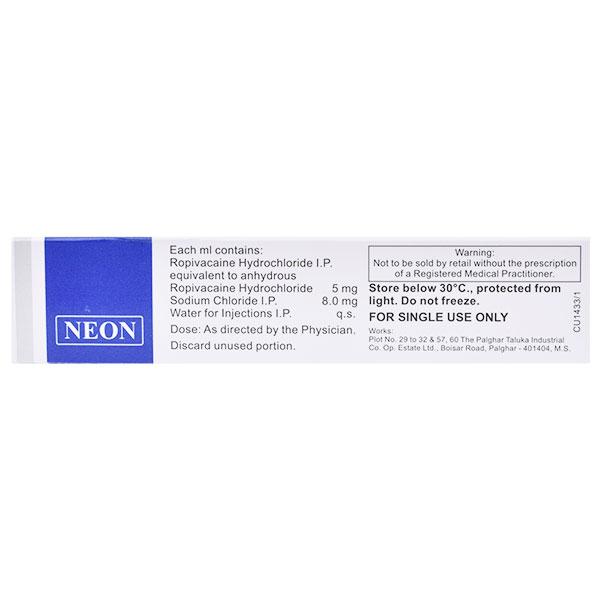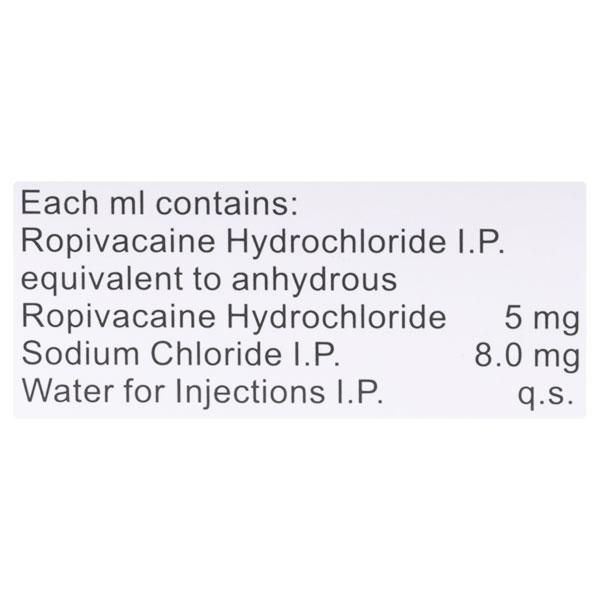

Netmeds First Membership
Quick Links
Introduction About ROPIN 0.5 INJECTION
ROPIN 0.5 INJECTION contains Ropivacaine which belongs to the group of medicines called Local Anaesthetics. It is used in children and adults of all ages for acute pain management. It numbs (anaesthetises) parts of the body Ex. after surgery.
ROPIN 0.5 INJECTION is not recommended for use in patients suffering from hypovolemia (decreased volume of blood). Consult your doctor before receiving it.
ROPIN 0.5 INJECTION should be used with caution in patients suffering from lung, liver, kidney, heart diseases, porphyria (a blood disorder). Consult your doctor before receiving it.
ROPIN 0.5 INJECTION should be used during pregnancy only if clearly necessary and inform your doctor if you are breast feeding as it is not known whether this medicine passes into breast milk.
ROPIN 0.5 INJECTION should be used with caution in new-born and children below 12 years of age and in elderly patients above 65 years of age. Consult your doctor before receiving it.
The most common side effects of receiving ROPIN 0.5 INJECTION are low blood pressure causing dizziness or light-headedness, nausea. Contact your doctor if any of the symptoms worsen.
Uses Of ROPIN 0.5 INJECTION
- For acute pain management in children and adults of all ages
- To numbs (anaesthetises) parts of the body Ex. after surgery
How ROPIN 0.5 INJECTION Works
ROPIN 0.5 INJECTION works by stopping the nerves from being able to pass pain messages to the brain. Thus ROPIN 0.5 INJECTION will stop you feeling pain, heat or cold in where it is used however you may still have other feelings like pressure or touch.
How to use ROPIN 0.5 INJECTION
ROPIN 0.5 INJECTION will be given to you only by a doctor as an injection or as an infusion into the region or near to the body part that needs to be numbed or as an epidural injection (into the area around the spinal cord). Your doctor will decide the exact dose and duration of management depending upon the type of pain relief you need, age, body weight and condition.
Side Effects Of ROPIN 0.5 INJECTION
Common
- low blood pressure causing dizziness, light-headedness
- nausea, vomiting
- difficulty in passing urine
- high blood pressure
- back pain
- fever or chills
- slow or fast heartbeat (bradycardia, tachycardia)
- pins and needles
- headache
Uncommon
- anxiety
- breathing difficulties
- hypothermia (low body temperature)
- fainting
- seizures
- numbness of the lips, tongue and around the mouth
- hearing problems
- visual problems
- problems with your speech,
- stiff muscles and trembling
Rare
- heart attack (cardiac arrest)
- arrhythmias (uneven heartbeat)
- damaged nerves
Stop receiving ROPIN 0.5 INJECTION and consult your doctor immediately in case you experience:
- serious allergic reactions (such as anaphylaxis) include sudden onset of rash, itching or hives, swelling of the face, lips, tongue or other parts of the body causing shortness of breath, wheezing or difficulty breathing
- signs and symptoms of methemoglobinemia include pale, grey or blue-coloured skin, headache, rapid heart rate, shortness of breath, light-headedness and fatigue
How To Manage Side Effects
Headache:
Rest and relax. Drink plenty of fluids such as water or ORS (Oral Rehydrating Solution) and apply a pain-relieving balm on the head if necessary. Contact your doctor if the headache did not improve.
Dizziness:
Try to rest and relax. Get enough sleep. Avoid driving or operating any machines while you are feeling dizzy. Contact your doctor if your dizziness did not improve.
Nausea and vomiting:
Receive the medicine, with or just after a meal. Stick to simple meals. Avoid eating oily or spicy food. Contact your doctor if your nausea and vomiting did not improve.
Warning & Precautions
Pregnancy
ROPIN 0.5 INJECTION should be used during pregnancy only if clearly necessary. Contact your doctor before receiving it.
ROPIN 0.5 INJECTION is not recommended for use in the neck of the womb to relieve pain during childbirth.
Breastfeeding
If you are breastfeeding, ask your doctor for advice as it is not known whether this medicine passes into breast milk.
Driving and Using Machines
ROPIN 0.5 INJECTION can make you feel sleepy and affect your action reaction speed. Do not drive or operate machines until the next day after receiving ROPIN 0.5 INJECTION.
Kidney
ROPIN 0.5 INJECTION should be used with caution in patients suffering from kidney diseases and requires dose adjustment. Consult your doctor before receiving it.
Liver
ROPIN 0.5 INJECTION should be used with caution in patients suffering from liver diseases and requires dose adjustment. Consult your doctor before receiving it.
Allergy
Do not receive ROPIN 0.5 INJECTION if you are allergic to ropivacaine or to other local anaesthetics such as lidocaine, bupivacaine or any of the other ingredients of this medicine.
Lungs
ROPIN 0.5 INJECTION should be used with caution in patients suffering from lung diseases. Consult your doctor before receiving it.
Heart Disease
ROPIN 0.5 INJECTION should be used with caution in patients suffering from heart diseases and requires dose adjustment. Consult your doctor before receiving it.
Others
ROPIN 0.5 INJECTION is not recommended for use if you:
- have hypovolemia (decreased volume of blood)
Before receiving ROPIN 0.5 INJECTION inform your doctor if you:
- have a rare blood disorder called porphyria or family history of porphyria
- have glucose-6phosphate dehydrogenase deficiency (hereditary disorder that affects red blood cells)
- have congenital or idiopathic methemoglobinemia (condition affects red blood cells)
Use in paediatrics:
ROPIN 0.5 INJECTION should be used with caution in new-born and children below 12 years of age. Consult your doctor before receiving it.
Use in geriatrics:
ROPIN 0.5 INJECTION should be used with caution in elderly patients above 65 years of age. Consult your doctor before receiving it.
Interactions
A. Drug-Drug interactions:
Before receiving ROPIN 0.5 INJECTION, inform your doctor if you are taking any of the following medicine:
- morphine, codeine (medicines used to manage severe pain)
- local anaesthetics such as bupivacaine, articaine, benzocaine, prilocaine, procaine, mepivacaine, tetracaine (medicines which induce numbness in a specific part of the body)
- mexiletine, lidocaine, amiodarone (medicines used for management of irregular heartbeat)
- fluvoxamine, imipramine (medicines used for management of depression)
- ketoconazole (used for fungal infections)
- nitric oxide, nitro-glycerine, nitroprusside (medicines used to manage high blood pressure and heart diseases)
- nitrous oxide (a medicine used in general anaesthesia or to manage severe pain)
- phenobarbital, phenytoin, sodium valproate (medicines used to manage fits)
- acetaminophen (a medicine used to manage fever and pain)
- metoclopramide (used for management nausea and vomiting)
- sulfasalazine (used for management inflammatory bowel disease)
- antineoplastic agents Ex. cyclophosphamide, flutamide, hydroxyurea, ifosfamide, rasburicase (medicines used to manage cancer)
- chloroquine, primaquine, quinine (medicines used to manage malaria)
- enoxacin, sulphonamides like silver sulphadiazine (used to manage bacterial infections)
- dapsone (used to manage leprosy)
- nitrofurantoin (used to manage urinary tract infections)
- para-amino salicylic acid (used to manage tuberculosis)
- theophylline (used to manage asthma)
Overdosage:
ROPIN 0.5 INJECTION will be administered to you only by a doctor in a hospital and so it is unlikely to receive an overdose. However, consult your doctor or nurse if you experience any unusual symptoms such as dizziness or light headedness, numbness of lips, tongue, around the mouth, hearing problems, visual problems, problems with your speech, muscle twitching, tremors, trembling, fits and loss of consciousness.
More Information
- Keep ROPIN 0.5 INJECTION out of reach of children
- Store ROPIN 0.5 INJECTION below 30°C
FAQs About ROPIN 0.5 INJECTION
What is ROPIN 0.5 INJECTION used for?
ROPIN 0.5 INJECTION is used in children and adults for all ages for acute pain management. It numbs (anaesthetises) parts of the body Ex. after surgery. Contact your doctor before receiving it.
Can ROPIN 0.5 INJECTION cause permanent loss of sensation?
No, ROPIN 0.5 INJECTION does not cause permanent loss of sensation. It gives pain relief for 5-6 hours. Contact your doctor if you experience pins and needles sensation or decreased sensation in the skin.
Is it safe to use ROPIN 0.5 INJECTION in pregnancy?
ROPIN 0.5 INJECTION should be used during pregnancy only if clearly necessary and it is not recommended for use into the neck of the womb to relieve pain during childbirth. Contact your doctor before receiving it.
How long does ROPIN 0.5 INJECTION take to work?
ROPIN 0.5 INJECTION will start producing the effect of numbness within a few minutes of administration and its effect lasts for 2-6 hours when ROPIN 0.5 INJECTION is used for pain management or to numb the body part.
Does ROPIN 0.5 INJECTION cause hypotension?
Yes, hypotension or low blood pressure (causing light-headedness, dizziness) is the most common side effect seen after administration of ROPIN 0.5 INJECTION. Contact your doctor if any of the symptoms are worse.
References
1. KD Tripathi. Local Anaesthetics. Essentials of Medical Pharmacology, 7th edition. 2013. page 367.
2. Ashley M. George, Mark Liu. Ropivacaine. NIH National Library of Medicine, National Center for Biotechnology Information. Statpearls. August 2022. [Accessed on 6th September 2022] https://www.ncbi.nlm.nih.gov/books/NBK532924/#article-43447.s3
3. Kuthiala G, Chaudhary G. Ropivacaine: A review of its pharmacology and clinical use. NIH National Library of Medicine, National Center for Biotechnology Information. PubMed Central. March-April 2011. [Accessed on 6th September 2022] https://www.ncbi.nlm.nih.gov/pmc/articles/PMC3106379/
4. Aspen Pharma Trading Limited. Health Products Regulatory Authority. [Revised in May 2022] [Accessed on 6th September 2022] https://www.hpra.ie/img/uploaded/swedocuments/6ed15cd6-edf0-4834-bf56-a673f6c06497.pdf
5. Aspen Pharma Trading Limited. Electronic Medicines Compendium. [Revised in July 2022] [Accessed on 6th September 2022] https://www.medicines.org.uk/emc/files/pil.1497.pdf
6. Sintetica Limited. Electronic Medicines Compendium. [Revised in October 2018] [Accessed on 6th September 2022] https://www.medicines.org.uk/emc/product/11022/smpc/print#gref
7. Fresenius Kabi USA, LLC. U.S. Food & Drug Administration. [Revised in November 2018] [Accessed on 6th September 2022] https://www.accessdata.fda.gov/drugsatfda_docs/label/2018/020533s035lbl.pdf
8. Ropivacaine. Themis Medicare. [Accessed on 6th September 2022] https://www.themismedicare.com/products/therapeutic-products
Useful Diagnostic Tests
- Electrocardiogram (ECG)
- Kidney function test










